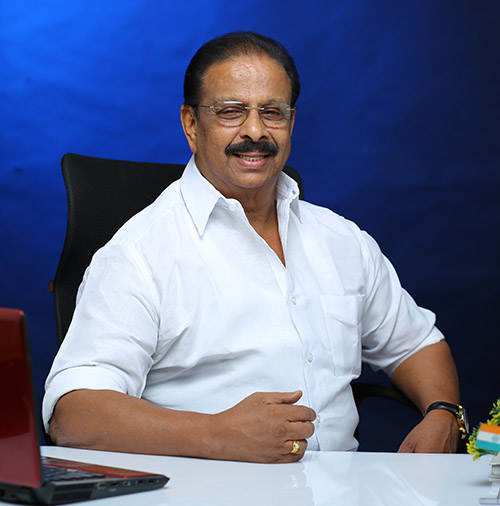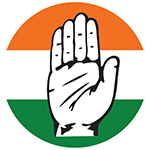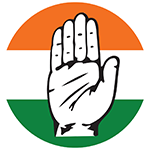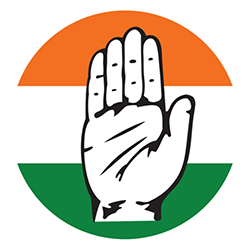About
K SUDHAKARAN, KPCC PRESIDENT
I am humbled and privileged to have been entrusted with the position of KPCC President by AICC President and the central leadership of Indian National Congress. I am indebted to the leadership for the confidence bestowed in me to lead the party in the state of Kerala. As a disciplined, committed Congressman, my sincere and determined efforts have been to make our party a political force has always been the welfare of the common people. My efforts as a party functionary throughout these years have been to ensure that the Congress is a party that weak and marginalized in the society can always rely on.
I have tried my best to stand by and voice the concerns of the ordinary party workers and well-wishers of the Congress party. As the KPCC President, my primary concern has been to run the party with a renewed focus on pro-people ideology and policies.
Indian National Congress always derives its strength from the people. In the context of the social and political challenges in India and Kerala at present, Congress is the only party that can represent the voice of the country.
Keeping the values that define Congress, let us work together with unity and discipline to stand for all sections of society and the shape the future of the country and the state.
I have tried my best to stand by and voice the concerns of the ordinary party workers and well-wishers of the Congress party. As the KPCC President, my primary concern has been to run the party with a renewed focus on pro-people ideology and policies.
Indian National Congress always derives its strength from the people. In the context of the social and political challenges in India and Kerala at present, Congress is the only party that can represent the voice of the country.
Keeping the values that define Congress, let us work together with unity and discipline to stand for all sections of society and the shape the future of the country and the state.

History & Formation
-
 Historiography - An account of KPCCThe national freedom movement significantly influenced the political history of Kerala. Here, an echo of the Salt Satyagraha was heard. The entrance of lower castes into the Vaikom temple via a Satyagraha was acknowledged as a direct challenge to the rulers' and, by extension, the British occupation's prevailing political and hierarchical supremacy. In addition to Gandhiji's physical presence, numerous Congress-led people's movements contributed to the Kerala national movement against the British. As a result of their leadership in various political movements opposing British rule, Congress ultimately transformed the freedom struggle in the state into a struggle for the rights of the state's people, particularly millions of impoverished and marginalized individuals, which had been violated.
Historiography - An account of KPCCThe national freedom movement significantly influenced the political history of Kerala. Here, an echo of the Salt Satyagraha was heard. The entrance of lower castes into the Vaikom temple via a Satyagraha was acknowledged as a direct challenge to the rulers' and, by extension, the British occupation's prevailing political and hierarchical supremacy. In addition to Gandhiji's physical presence, numerous Congress-led people's movements contributed to the Kerala national movement against the British. As a result of their leadership in various political movements opposing British rule, Congress ultimately transformed the freedom struggle in the state into a struggle for the rights of the state's people, particularly millions of impoverished and marginalized individuals, which had been violated. -
 MILESTONES - The Role of Congress and the Development of the National MovementSince ancient times, the British Supremacy's ruthless exploitation and dominance sparked countless rebellions; by the turn of the 19th century, the enraged multitudes were attempting to emancipate themselves from the burden of British dominance. The Congress Party was a prominent advocate for accountability and resistance against the heinous acts committed by the British regime within the state. The Congress party was extremely outspoken during that era in opposition to prevalent social inequities, including untouchability and social isolation.
MILESTONES - The Role of Congress and the Development of the National MovementSince ancient times, the British Supremacy's ruthless exploitation and dominance sparked countless rebellions; by the turn of the 19th century, the enraged multitudes were attempting to emancipate themselves from the burden of British dominance. The Congress Party was a prominent advocate for accountability and resistance against the heinous acts committed by the British regime within the state. The Congress party was extremely outspoken during that era in opposition to prevalent social inequities, including untouchability and social isolation.
The Congress movement began to spread throughout India towards the close of the 19th century. Numerous notable individuals were affiliated with the Indian National Congress from Kerala. Sir, G.P. Pillai. Included among them were C. Sankaran Nair and Rairu Nambiar. C. The inaugural Malayali to preside over congress sessions for an extended period of time was Sankaran Nair, a native of Ottapalam. In the year 1897, he assumed the presidency of the Amaravathi Session of the Congress. In Malabar, Congress activities acquired momentum by 1919. The influence of Gandhiji on the state congress grew during the 1920s. The Khilafat movement, Salt Satyagraha, and noncooperation in Malabar sparked the nation's pride. Among the early pioneers of the Malabar liberation movement were K. K.P. Kesava Menon, Muhamed Abdurahiman Kelappan, and K. Nair, Madhavan.
This national movement was propelled by Mahatma Gandhi, who also exerted an extraordinary impact on the state's liberation struggle. The inferior social classes were regarded as untouchables and were not permitted to traverse even the roads leading to temples in Kerala. The backward social strata gained access to the public roads adjacent to the Vaikom temple through the nonviolent Guruvayoor Satyagraha movement and the Vaikom Satyagraha movement, both of which were led by Gandhiji. Sree Chithira Thirunal Balaramavarma Maharaja, the sovereign of Thiruvithamkur, issued the Temple Entry Proclamation in 1936, permitting individuals of all castes to enter this temple.
The British implemented stringent regulations on salt production and levied high taxes on the country's citizens in 1930. Under the leadership of K., this infuriated the populace of Kerala and the entire nation. Salt was produced at Kelappan, where opposition to the law was encountered. Salt laws were violated in numerous locations, with Payyannur and Kozhikode being particularly affected, resulting in the apprehension of hundreds of agitators. Other notable leaders such as K.P. Kesava Menon, Ahmad Abdurahiman Muhammed, and K. Similarly, Madhavan Nair was involved in each of these state-wide movements.
The character of the freedom movement in Thiruvithamkur was notably dissimilar. The influence of caste organizations in Thiruvithamkur was significant. Within the city limits, these organizations advocated for social equity and the adequate representation of disadvantaged segments of the population in government positions and the legislature. In addition, the Travancore State Congress was established, with notable leaders including T.K. Madhavan, T.M. Varghese, C. Kesavan, and Pattam Thanupilla. Its members fought for the rights of the state's populace that had been violated during British rule. Significant influencers in the formation of Prajamandalam were Ikkanda Warrier and Panampilly Govinda Menon, both of whom were born in Cochin.
The Malabar District was not devoid of adherents of the Home Rule Movement. Sri. Secretary of both the Congress Committee and the Home Rule League was K.P. Kesava Menon. His political activities galvanized the entire Malabar district. In Malabar, the national movement experienced a surge in support and influence during the First World War. Concurrently, the Muslim populace of Malabar was incensed by the Khilafat movement. The Malabar rebellion of 1921 stood as the most significant occurrence associated with the political movement in Malabar to this time. 61 of the 90 Mapillas who were being transported as captives in a closed railway goods wagon from Tirur to Coimbatore perished of suffocation during the "Wagon Tragedy," one of the tragic events associated with this rebellion. The insurrection of 1921 constituted a significant national unrest that challenged the authority of the British.
The Congress personnel appeared to have been dormant in the immediate aftermath of the uprising. In contrast, Sri. A few other Congress employees, including K. P. Kesava Menon, established the Mathrubhumi, a Malayalam daily based in Calicut, with the intention of disseminating the Congress's message. The Salt Satyagraha, which commenced in 1930 under the guidance of Gandhiji, also influenced the state of Kerala. The Salt Sathyagraha in Malabar primarily took place in Payyannur. Long after this, Malabar eventually emerged as the focal point of nationwide movements in Kerala.
The British government regarded the Congress as a "illegitimate organization" during the Second Phase of the Civil Disobedience Movement in 1932. The participation of thousands of men and women in the agitation in Malabar rendered the government's threats futile. The withdrawal of the Civil Disobedience Movement was followed by a schism in the Congress Party viz. including both leftists and rightists. The Communist Party of Malabar was established in 1939 from the Congress party's radical faction. They abandoned the Gandhian Principles after being inspired by the Russian Revolution. However, they opposed the foreign government in solidarity with the Congress.
The Congress persisted in its ardent pursuit of liberty following the conclusion of the Second World War. Even subsequent to its liberation in August 1947, Malabar remained an administrative region of the Madras state. The Madras Legislature was augmented by four seats won by the Congress Party of Malabar in the general election of 1951. The state reorganization that occurred on November 1, 1956 resulted in the creation of Kerala, a new state formed by the merger of Travancore, Cochin, and Malabar.
The names of the Malabari freedom fighters included K. The period was marked by the prominence of Kelappan, K. P. Kesava Menon, K. Madhava Menon, Muhammed Abdur Rahiman, and Moidu Maulawi.
-
 ACTIVITIES - Travancore and Cochin's integration and the establishment of Kerala stateDuring the early British colonial period, the princely states of Travancore and Cochin engaged in internal conflicts and demonstrations to advocate for the rights of their respective populations. The initial agitations were directed toward the implementation of effective governance. Subsequently, an ongoing resistance emerged in pursuit of political rights, encompassing the representation and participation of individuals at every level of government.
ACTIVITIES - Travancore and Cochin's integration and the establishment of Kerala stateDuring the early British colonial period, the princely states of Travancore and Cochin engaged in internal conflicts and demonstrations to advocate for the rights of their respective populations. The initial agitations were directed toward the implementation of effective governance. Subsequently, an ongoing resistance emerged in pursuit of political rights, encompassing the representation and participation of individuals at every level of government.
Shri. Kesavappillai, a representative from Trivandrum, attended the inaugural session of Congress that was convened in Bombay on December 28, 1885. Travancore had a modest representation in the early years of Congress formation at the national level. Barrister G.P Pillai established the Malayalee Memorial in 1891 to advocate for the rights of locals in government service. The Congress convention held in Amaravati was presided over by Shri. C. Sankaran Nair in 1897. A branch of the Congress was established in Trivandrum in 1929, and the party unit's secretary was Barrister A.K Pillai. In the same year that the KPCC was established in Ottapalam, Later in 1921, Riverdrum also established a congress committee.
Travancore was immediately affected by the civil disobedience movements that Gandhiji initiated in 1920. The state's Congress Committee coordinated demonstrations, processions, and a boycott of British products. Travancore experienced one of its most turbulent political unrest periods in its history during the early 1930s. Commencing as a form of resistance against the constitutional reforms implemented in 1932, the Nivarthana movement emerged. The agitation ultimately resulted in success, notwithstanding the repressive measures implemented by the government. Precise deliberations were conducted regarding each community in response to the agitation.
The Travancore State Congress was established in 1938. Presided over initially was Pattom Thanu Pillai. C. The State Congress also included notable figures such as Kesavan, P. K. Kunju, and T.M. Varghese. The objective of the nascent organization was to secure a government that was entirely accountable to the citizens of Travancore.In Travancore, the Quit India Movement failed to elicit any violent opposition. However, the political landscape of Travancore became overshadowed by ominous clouds during the postwar era. The proposal for constitutional reforms put forth by Sir C. P. Ramaswamy Aiyer in January 1946 included the establishment of an irrevocable executive branch, inspired by the "American model." The State Congress deemed the proposal to be unlawful and rejected it.
A sequence of extraordinary occurrences that transpired between 1946 and 1947 came to a dramatic conclusion with the establishment of responsible government in Travancore. When did Sir begin in July 1947? C. P. Ramaswamy Iyer declared that Travancore would attain independence on the date of the British withdrawal from India. Both within and without the state, the Diwan's proclamation sparked considerable controversy. The ineffectual application of force by the government in response to the statewide mass movement spearheaded by the Congress party was evident. After the Diwan was assaulted, he departed Travancore and tendered his resignation from office. The state's quest for accountable governance concluded triumphantly with the conclusion of that conflict. Pattom Thanu Pillai, T. M. Varghese, and C. T. established the first well-known ministry in Travancore. March 24, 1948 marked Kesavan's ascension to authority.
-
 STRUCTURE - Formation of Kerala State through the union of Travancore and CochinThe state ministry of the government of India, under the leadership of Sardar Vallabhai Patel, instituted a policy for the merger and integration of states, which laid the foundation for the integration of Travancore and Cochin. The consequence of this was the establishment of the State of Travancore-Cochin on July 1, 1949. Travancore Maharaja Sri Chitira Tirunal Bala Rama Varma was bestowed with the title of Rajapramukh of the new state, while the Maharaja of Cochin was granted a pension. The legislative and ministerial bodies of the two states were merged to establish the Travancore-Cochin legislature and ministry, respectively.
STRUCTURE - Formation of Kerala State through the union of Travancore and CochinThe state ministry of the government of India, under the leadership of Sardar Vallabhai Patel, instituted a policy for the merger and integration of states, which laid the foundation for the integration of Travancore and Cochin. The consequence of this was the establishment of the State of Travancore-Cochin on July 1, 1949. Travancore Maharaja Sri Chitira Tirunal Bala Rama Varma was bestowed with the title of Rajapramukh of the new state, while the Maharaja of Cochin was granted a pension. The legislative and ministerial bodies of the two states were merged to establish the Travancore-Cochin legislature and ministry, respectively.
Leader of the first popular ministry in Travancore-Cochin was T. Travancore's Chief Minister is K. Narayana PiIlai. 44 out of 108 seats in the state legislature were won by the Congress Party in the general elections of 1951-52. In February 1954, during the midterm elections, Panampilli Govinda Menon, who was affiliated with the Congress, assumed the ministry. March 1956 saw the downfall of this cabinet. The state experienced its initial period of President Rule subsequent to the decline of this ministry. November 1, 1957, was the date of Kerala's formation.
-
 DEVELOPMENTS - Developments in politics subsequent to the establishment of the state and Congress PartyThe inaugural general election for the State Legislature of Kerala took place in February 1957. A handful of independent candidates and the Communist Party of India secured 65 of the 126 seats in the legislature. The Communist Ministry was established under the Chief Minister of Egypt on April 5, 1957, following the end of Presidents Rule. The authority was seized by M. S. Namboothiripad. Opposition arose in every region of the state in response to the Communist Government's anti-people policies and ruthless methods of cell rule. This resulted in countless agitations throughout the state, ultimately culminating in the regime's overthrow in 1959. Kerala once more was placed under the presidency.
DEVELOPMENTS - Developments in politics subsequent to the establishment of the state and Congress PartyThe inaugural general election for the State Legislature of Kerala took place in February 1957. A handful of independent candidates and the Communist Party of India secured 65 of the 126 seats in the legislature. The Communist Ministry was established under the Chief Minister of Egypt on April 5, 1957, following the end of Presidents Rule. The authority was seized by M. S. Namboothiripad. Opposition arose in every region of the state in response to the Communist Government's anti-people policies and ruthless methods of cell rule. This resulted in countless agitations throughout the state, ultimately culminating in the regime's overthrow in 1959. Kerala once more was placed under the presidency.
Kerala State Legislature elections were re-conducted in February 1960. In opposition to the Communist Party, the Congress, the P.S.P., and the Muslim League formed an alliance. The Congress-P.S.P coalition established a ministry with Pattom subsequent to the alliance's triumph. The swearing-in of Chief Minister A. Thanu Pillai on February 22, 1960 marked the conclusion of President's Rule. Pattom was born in September of 1962. Governor of the state of Punjab, A. Thanu Pillai, was appointed to the position. R. The chief of the Congress Party, Sankar, was appointed as the Chief Minister. The ministry tendered its resignation on September 10, 1964. Kerala State once more came under the governance of the President subsequent to the downfall of the Sankar Ministry. The Marxist Communist Party's division within the Communist Party was the most significant political development of the era.
All political parties, including Congress, ran independently in the 1965 midterm elections, lacking any electoral alliance. Thus, in the new legislature, none of the parties received a clear majority of representatives. President's Rule was instituted in Kerala on March 24, 1965, subsequent to the dissolution of the recently elected Legislative Assembly.
Elected to power in the General Election of 1967 under the leadership of E. Marx was the Communist Party. Namboothiripad, M. S. M. Nonetheless, this ministry was overthrown in October 1969, and on November 1, 1969, a new non-Marxist coalition ministry was inaugurated under the leadership of C.Achutha Menon, the leader of the C.P.I. The Congress party was among this front's principal allies.
In order to pursue a new mandate, the Achutha Menon Ministry tendered its resignation on August 1, 1970. A unified front led jointly by the Communist Party of India and the Indian National Congress won an overwhelming majority in the September 1970 General Election. A newly established ministry led by C. Attained to power was Achutha Menon. Nevertheless, the general elections that were scheduled to occur in Kerala in 1976 were rescheduled subsequent to the President of India's proclamation of Emergency in June 1975.
During the period of emergency, the Congress party supported Indiraji, and Kerala experienced a remarkably tranquil political and social climate. March 1977 saw the convening of general elections subsequent to the withdrawal of the Emergency. The elections were won by a coalition lead by the Congress. March 23, 1977 marked the inauguration of a new ministry led by K. Karunakaran, the chief of the Congress Legislature Party. A month later, the Chief Minister was compelled to tender his resignation, putting an end to the Karunakaran Ministry. Following the collapse of the Karunakaran Ministry, a new ministry led by A.K. was established. Respected Antony. This ministry occupied power between 1977 and 1978. P.K. presided over the newly established Ministry that commenced operations on October 29, 1978. Under the leadership of Vasudevan Nair, the C.P.L. remained in power until October 12, 1979. Another Ministry, which was led by the leader of the Muslim League, C.H. In 1979, Muhammad Koya was in office between October 12 and December 5. On December 5, 1979, following the resignation of the Koya ministry, President's Rule was proclaimed. In January 1980, elections for the Legislative Assembly were conducted. The Ministry of the Democratic Front on the left, led by E.K. Nayanar, the chairman of the Marxists, assumed office on January 25, 1980.
On October 20, 1981, the Nayanar Ministry was deposed as a result of the Congress group's cessation of support; Kerala was once more placed under President's Rule. K. established a new ministry under the Congress. December 25 marked the inauguration of Karunakaran. However, his survival was short-lived. An additional period of President's Rule was imposed in Kerala between March 17 and May 23, 1982.
The Congress-led United Democratic Front, which won the general elections for the Kerala Assembly in May 1982, assumed power on May 24, 1982, with K. Mr. Karunakaran is the Chief Minister. It maintained its position for an entire term. The Kerala Legislative Assembly general election in March 1987 resulted in the United Democratic Front's defeat. On March 25, 1987, the L.D.F ministry, led by C.P.M leader E.K. Nayanar, assumed power in Kerala. The ministry was dissolved by the Chief Minister in 1991, and he was presented with a new mandate prior to the customary conclusion of his term in office. The party U.D.F., which was headed by Congress, seized power. K. Karunakaran was installable as chief minister. Kirunakaran tendered his resignation on March 16, 1995, while A.K. Twenty-first March 1995 saw Antony's inauguration as the new chief minister. May of that year witnessed the occurrence of general elections in 1996. With a simple majority, the LDF reestablished itself as the ministry's leader under E.K. Nayanar assumed authority. He resigned at the end of his term, followed by Shri, after the Congress-led UDF won an overwhelming victory in the 2001 assembly elections (100 out of 140 seats). Sworn in as the chief minister is Oommen Chandy.
At this time, a Congress-led government led by Chief Minister Oommen Chandy and collaborating with the UDF are prioritizing the state's development and assisting its impoverished and marginalized citizens. In addition to supporting the government's initiatives, the Congress party, led by Shri. Ramesh Chennithala, engages in a variety of activities to publicize the government's accomplishments and safeguard it from the opposition parties' politically motivated attacks. With improved coordination, the Party leadership and government instill confidence in the party with regard to policy matters. The party and government will take the lead in promoting rapid development, communal harmony, and care for all those in need of government assistance.







